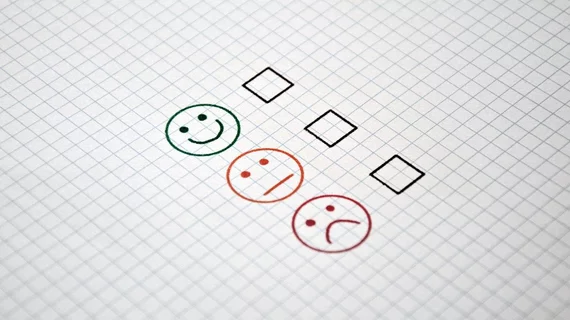Radiologists experience significantly less happiness, meaning in their work than docs in other departments
Radiologists experience significantly less happiness and meaning in their work than peers in other clinical departments, according to a new single-center analysis published Saturday.
This discrepancy occurred despite imaging physicians reporting burnout rates that are nearly identical to their nonradiologist counterparts. The specialty also scored much lower in responses to questions related to whether they felt “highly valued” for their work or respected by leadership, researchers detailed in Academic Radiology.
“Fostering direct contact with patients and with clinical colleagues, reducing administrative tasks, targeted efforts to recognize clinical excellence, and more control over the work schedule are all areas that a radiology practice may focus on to reduce burnout among their physicians,” study author Catherine Giess, MD, with the Department of Radiology at Brigham and Women's Hospital in Boston, and colleagues wrote Nov. 7.
For their study, Giess et al. analyzed 2017 responses to the Stanford Physician Wellness Survey, administered to physicians at a large, urban academic medical center. The analysis reached 15 different departments, with responses covering 11 domains, ranging from professional fulfillment to sleep difficulties, perceived appreciation, and control over one’s work schedule. All told, 162 radiologists filled out the survey, alongside 1,353 physicians in other specialties. There was no significant difference in the gender breakdown, the team noted, but rad responses did skew younger.
Past surveys have found higher rates of burnout among the specialty when compared to others, the authors noted. However, Giess and colleagues discovered that about 35.7% of radiologists experienced such workplace fatigue, about the same as the 35.2% clip among the rest of respondents. Despite that relatively even mark, physicians in imaging ranked much lower in perceiving their job as joyful (with a Z score of -2.67, or nearly 3 standard deviations below the mean). Same for finding work meaningful (-2.77), being perceived as highly valued (-2.55), and feeling that leadership treats them with respect and dignity (-3.44). Meanwhile, radiologists scored significantly better than others in responses related to sleep impairment and the negative impact of work on personal relationships, the authors found.
The analysis had several limitations, Giess and colleagues cautioned, with no ability to discern between imaging subspecialties, clinician types in the nonradiology group, nor differences in duties and workload. Nevertheless, the team believes this information is useful as practice leaders devise how to address unhappiness among their rad ranks.
“In conclusion, in this study utilizing the Stanford Wellness Survey, although self-reported burnout was similar between radiologists and nonradiologist peers, radiologists were less likely to find work meaningful and more likely to feel unhappy and undervalued in the workplace and by leadership,” they advised. “Initiatives to increase perceived appreciation, leadership relationships, and meaningfulness of work for radiologists may reduce burnout,” they added.
Read the rest of the analysis in Academic Radiology here.

